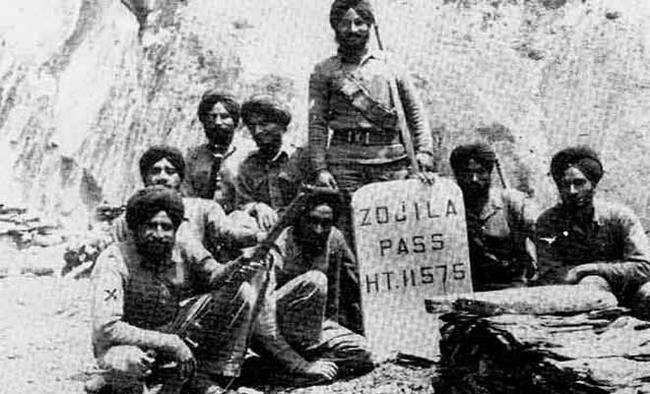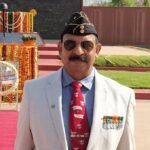India was declared as an independent country at 0001 hours on August 15, as millions of Indians witnessed hoisting of Tricolour by first Prime Minister Pundit Jawaharlal Nehru. He said, “We rise from darkness to a new dawn of hope”. The tragedy was that it was not united India but split into two nations India and Pakistan by the illogical and in hurry demarcation by Lord Radcliffe. The largest ever migration commenced with horrific tales of murders, rapes, arson and looting especially in state of Punjab and Bengal. It was also decided that British Indian Army will be split and initially will remain under British officers. Field Marshal Sir Claude Auchinleck was appointed as Commander-in- chief of both Armies for better control. General Sir Frank Messervy was appointed C-in-C of Pakistan Army and General Robert Lockhart was honoured with command of Indian Army, who was replaced by General Roy Bucher in 1948. Supreme Commander Field Marshal Auchinleck was to operate under direction of Joint Defence Council consisting of four members including himself, Lord Mountbatten, Viceroy and two Defence ministers of India and Pakistan. A Joint force of 55,000 troops, named Punjab Border Force was raised by Major General T W Rees to control the communal riots and ensure safe, orderly movement of refugees between two nations. He had two strong deputies Brig D S Digambar and Brig Mohmad Ayub Khan (Later President of Pakistan). After commendable difficult task, the PBF was disbanded. The Supreme Commander ceased to be member of Defence Council w.e.f. December 1, 1947 and Defence Council was closed on April 1, 1948.
Since the Princely states were given the option to join any of the dominion on independence, Kashmir, Junagadh, Hyderabad and Goa wished to remain an independent entity. Dogra dynasty had ruled the state of Jammu Kashmir for almost 100 years. Maharaja Hari Singh, the current ruler knew the 75 % combined population of Jammu, Valley and Ladakh was Muslim. He wanted to be friendly to both nations and sign an agreement of neutrality. Pakistan offered huge economic aid and assistance. A secret operation to capture Kashmir, was launched on September 1, 1947 called Operation Gulmarg. Thousands of tribal raiders officered by Pak Army officers infiltrated into Poonch, Muzaffarabad, Uri, Tithwal, Kargil, Dras. Maharaja realised the double game Pakistan was playing and he rightly assessed that soon his regime will be over thrown. He approached British Govt for help but was refused. He contacted Indian Prime minister who was told by Mountbatten that unless instrument of Accession is signed, no action could be taken. There was a clash between Raiders and 4th battalion of Kashmir state forces led by Col Naraian Singh, which was holding frontages of 80 kms from Tithwal to Kohala. Its HQ was at Domel.
On October 22, 1947, the Raiders attacked Bn HQ of 4th Battalion. They were joined by Muslim troops of same battalion and killed the CO and other comrades. The force of 5000 Raiders captured Domel, Muzaffarabad and Uri on October 23. Brigadier Rajender Singh, Chief of Kashmir State forces was also killed while protecting Baramula was awarded MVC. On October 24, Baramula was captured and Raiders played mayhem. The Raiders celebrated with orgy of rape, looting, massacre and destruction. There was a lull of 48 hours. Now, Maharaja decided to sign instrument of accession. On October 25, 1947, Secretary of State Ministry, flew to Srinagar with the document and the instrument of accession was signed in the evening and thus, Jammu Kashmir became the integral part of Union of India.
Defence committee of the cabinet under Governor General approved the accession and warning order for move of Indian troops was given to C in C India, General Lockhurst. He had already fore warned General Dudley Russell, GOC IN C Delhi and East Punjab Command. 50 Para brigade was nominated. 1 Sikh under Lt Col Dewan Ranjit Rai, located at Gurugram concentrated at Palam / Willingdon Airport on October 26 midnight and was airlifted to Srinagar on October 27, 1947. Tactical HQ and two companies landed at Srinagar by 1000 h. The CO secured airport with HQ troops and moved two companies to Baramula by road and also secured Sopore approach. CO, 1 Sikh was martyred while withdrawing from Baramula to Pattan, was awarded MVC on October 29, first Indian Army officer to be awarded for gallant rear guard action. He is truely called the saviour of Srinagar. A and B coy also arrived. Major battle was fought at Pattan and Badgam. 1 Para (Kumaon) also reached Srinagar. Tactical HQ of 161 Brigade under Brig J C Katoch was inducted and assumed command of operations. 4 Kumaon was also flown in for protection of Srinagar. Col Harbaksh Singh volunteered for his battalion but later, took over command of 161 Bde as Brig Katoch was evacuated. Operation JAK was launched. Major Somnath Sharma made supreme sacrifice while fighting 500 raiders, who had surrounded his coy at Badgam in outskirts of Srinagar. 4 Kumaon suffered heavy casualty – 46 killed/wounded, but they destroyed the offensive of Raiders by killing 200 of the attackers. He was awarded first Param Vir Chakra of Indian Army.
Once Srinagar was declared safe, Indian Army launched the offensive. At Shalateng, the attack was launched on November 7 and four hundreds of Raiders were killed. Baramula and Uri were recaptured. The focus now was diverted to Poonch and Uri Linkup. 1 Para captured Hazi Pir and reached Poonch and cleared it of enemy. Pakistan opened new fronts and captured Gilgit and Skardu by subversion. Kargil, Dras and Zojila pass were in enemy hands in July 1948. Leh garrison was under threat. On August 19, 1948, 2/8 Gorkhas were the only troops defending Leh under Lt Col H S Parab who was tasked to hold last man last bullet. General K S Thimayya, DSO, decided to clear the Zojila pass area and recapture Dras and Kargil and establish link up with Leh before snowfall of 1948.
Zojila is the gateway to the Ladakh region and Tibet. It is located at the height of 11,575 feet. The locals call it as Pass of Blizzards. It is one of the most dangerous pass prone to sudden avalanche, snow storms and blizzards. In 1947, there existed a road between Srinagar and Sonamarg but beyond was Yak track till Zojila and Dras, not motor able and usable only from May to October end. The pass remained closed for six months. The command structure in 1948 was reorganised. Lt Gen Carriappa was appointed as Western Army Cdr. Lt Gen S M Sri Nagesh was nominated as Jammu Kashmir theatre commander. Two divisions were raised at Jammu and Srinagar. Major General K S Thimayya was moved from Army Headquarters to take over Srinagar Division. Lt Col Rajinder Singh Sparrow, Commandant 7 Cavalry was operating in Uri Sector with his RHQ and one armoured car squadron and one Tank sqn was in Akhnoor. He was invited for Special Breakfast on September 23, 1948 at Srinagar State Guest house and was asked by Gen Carriappa, “Can Armour breakthrough the wall of Zojila and create a history and save Ladakh“. Sparrow without flicking his eyelid said, “Yes, We can”. 77 Para brigade commanded by Brig K L Atal was already operating in Baltal, Zojila area but had suffered severe casualties. Zojila, Gumri, Dras were already with enemy. In spite of inclement weather, Stuart tanks of C sqn of 7 Cavalry broke through Zojila under Capt S D S Jamwal at 1030 h on November 1, 1948. The enemy fled in panic. Hundreds of raiders were killed. Ghumri and Dras were cleared by 77 Para Bde. Link up with Leh garrison force took place at Kargil on November 23, 1948. A ceasefire was declared on January 1, 1949. Befittingly, it was this last battle of Kashmir War, the battle of Zojila, which was a watershed and had ensured Ladakh province remained with Indian Union. Military Leadership wanted to continue war and liberate whole of Kashmir but Political leadership was in hurry to conclude War and the menace of Pak Occupied Kashmir was created. The valour stories are many, but few were exceptional.
Major Somnath Sharma, 4 Kumaon
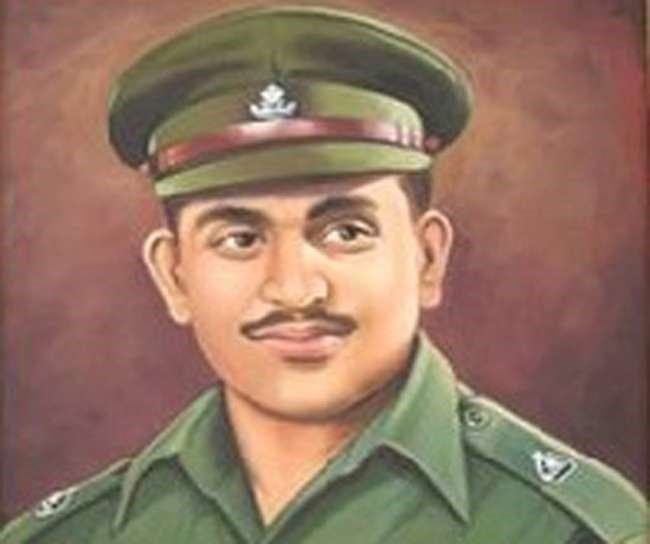 He was the first Indian soldier of Independent India to be awarded with the newly constituted Param Vir Chakra for his supreme sacrifice and outstanding gallantry in fight against Raiders supported by Pak Army near Badgam village close to Srinagar Airfield in valley on November 1, 1947. He belonged to the family of soldiers in uniform. His father was Maj Gen AN Sharma, the first Director of Medical Services of Indian Army and his two younger brothers have distinguished themselves as the Chief of Army Staff and Engineer in Chief. He was born on January 31, 1922 at Jammu Kashmir and studied in Sherwood College at Nainital and then joined Royal Indian Military College. He completed his senior Cambridge and joined Indian Military Academy and was commissioned in to 8/19 Hyderabad regiment in 1942. He participated in Burma campaign and was awarded Mention in Despatch. He was loved by his troops. He volunteered to be with his company even when he had a fractured hand during Kashmir operations of 1947.
He was the first Indian soldier of Independent India to be awarded with the newly constituted Param Vir Chakra for his supreme sacrifice and outstanding gallantry in fight against Raiders supported by Pak Army near Badgam village close to Srinagar Airfield in valley on November 1, 1947. He belonged to the family of soldiers in uniform. His father was Maj Gen AN Sharma, the first Director of Medical Services of Indian Army and his two younger brothers have distinguished themselves as the Chief of Army Staff and Engineer in Chief. He was born on January 31, 1922 at Jammu Kashmir and studied in Sherwood College at Nainital and then joined Royal Indian Military College. He completed his senior Cambridge and joined Indian Military Academy and was commissioned in to 8/19 Hyderabad regiment in 1942. He participated in Burma campaign and was awarded Mention in Despatch. He was loved by his troops. He volunteered to be with his company even when he had a fractured hand during Kashmir operations of 1947.
On November 2, 1947, the Raiders were heading towards Srinagar from various direction. 1 Sikh carried out a gallant action and stalled the main offensive but a strong group dressed as shepherds were hiding near Badgam. Major Somnath Sharma’s company was ordered a fighting patrol to Badgam village. He reached objective at dawn and deployed his company in south of Badgam. The enemy, estimated 700, attacked his company with mortars and machine guns. The company surrounded from three sides, gave a valiant fight but sustained severe casualties. Fully realising the gravity of situation and threat to Srinagar Airport, Major Sharma motivated his troops to fight last man last bullet till reinforcements arrive and hold at any cost. He also directed own Aircrafts to bomb the Raiders by placing cloth Air strips to demarcate forward line of own troops under direct fire of enemy weapons. He personally helped the LMG crew with filling magazines with his fractured hand. A mortar had a direct hit and exploded in his trench and killed him instantly. 300 Raiders were killed. The company delayed enemy for six long hours and the position was reinforced by reserve Company and vital Srinagar Airport was saved. His leadership, gallantry and tenacious defence were such that his man were inspired to fight the enemy four times in strength. The company beat three attacks. His last transmission to Brigade Headquarters before he was killed was “The enemy are just 50 yards from us. We are heavily outnumbered and under devastating fire but l shall not withdraw an inch and will fight last round”. He is rightly called the saviour of Srinagar Airport. For his gallant action, conspicuous bravery under heavy enemy fire and motivating troops till the end, he was awarded the highest gallantry award Param Vir Chakra of Independent India posthumously.
Naik Jadunath Singh, 1 Rajput
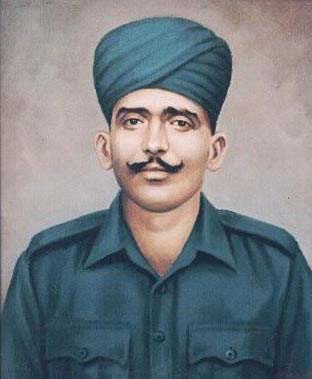 He was born in 1926 at Village Khajuri in Shahjanpur district in Uttar Pradesh at the house of Shri Birbal Singh Rathore. He studied till class IV in village school and worked in fields. He was an excellent wrestler and was nicknamed Bajragi Balbharmchari. He never got married. He was enrolled into the Rajput Regiment on November 21, 1941 at Rajput centre, Fatehgarh and was posted to 1 Rajput. He saw action during Second World War and was promoted to Naik in 1947.
He was born in 1926 at Village Khajuri in Shahjanpur district in Uttar Pradesh at the house of Shri Birbal Singh Rathore. He studied till class IV in village school and worked in fields. He was an excellent wrestler and was nicknamed Bajragi Balbharmchari. He never got married. He was enrolled into the Rajput Regiment on November 21, 1941 at Rajput centre, Fatehgarh and was posted to 1 Rajput. He saw action during Second World War and was promoted to Naik in 1947.
His battalion was deployed at Tein Dar for the defence of Naushera between Uri and Pattan. He was holding a piquet of a forward section post on February 6, 1948, when it was assaulted by about 200 Raiders. There were 9 men at the post, who repulsed the first wave of attack. Naik Jadunath led from front and displayed great valour. Four men were wounded and had to be evacuated. The second attack came after two hours again in large strength. Rajputs under Naik Jadunath blunted the attack and killed about 50 Raiders. He reorganised his section to face the third wave and injured himself badly with dead littered around. He was left alone. The third wave came soon after. He charged his last magazine of Sten gun, fixed bayonet and jumped out to face the enemy. He killed another 10 of the Raiders and was fatally shot in head and chest. He killed few more in close combat before falling. Thus, the NCO performed highest act of gallantry and self-sacrifice. He alone faced the enemy till last and prevented his post to be over run. For the unparallel valour and extraordinary courage and bravery, he was awarded the second Param Vir Chakra of War.
Second Lieutenant Rama Raghoba Rane, Engineers
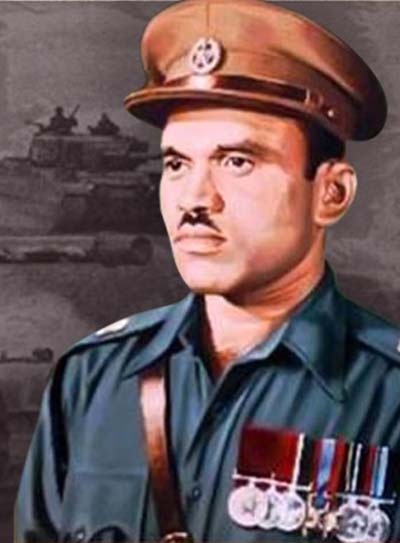 He was born on June 26, 1918 at village Chendia, North Kanara in Maharashtra. He was commissioned in Corps of Engineers on December 15, 1947 and finally retired in 1968 in Pune. He had earned 5 Mention in Despatches during Kashmir operations. Jhangar was lost to Pakistani Raiders in December1947 and later recaptured in March 1948. Indian Para brigade advanced from Naushera to Rajauri via Chingas, where major action took place.
He was born on June 26, 1918 at village Chendia, North Kanara in Maharashtra. He was commissioned in Corps of Engineers on December 15, 1947 and finally retired in 1968 in Pune. He had earned 5 Mention in Despatches during Kashmir operations. Jhangar was lost to Pakistani Raiders in December1947 and later recaptured in March 1948. Indian Para brigade advanced from Naushera to Rajauri via Chingas, where major action took place.
2 Lt Rane was a dare devil officer. 50 Para bde was advancing from Naushera to Rajouri on April 8, 1948. The task was to clear all enemy localities en route. The route was hilly and with thick jungles hair pin road bends. He was leader of the mine and road block clearing party. Tanks of 7 Cavalry were also leading the Infantry columns. At 1100h, near milestone 26, at Nadpur South, there was heavy mortar fire. Two men were killed and he himself was wounded. In spite of heavy enemy fire, he cleared the road block making safe lane for Tanks /armed Cars to resume advance. He cleared number of mine traps and road blocks with complete disregard to personal safety. The columns reached Barwali ridge at 1630 h. The tanks had to advance but enemy fire prevented forward move. Rane and his team worked throughout the night and made diversion. He mounted leading troop carrier himself on April 9 and led the advance. The tanks followed but again a Pine tree blocked the road. He blasted it with an IED and cleared the route. He cleared ten more road traps under fire. Again on April 10, he and his team started clearing road blocks from 0200 am in early morning and by first light route was fit for Tank columns. He blasted the Tawi embankments and Tanks bypassed the road blocks and moved in river bed. The road to Chingas was opened. The enemy positions were neutralised by Tank fire. By April 11, 1948, Indian troops recaptured Chingas and linkup with Rajouri was established. For exemplary devotion to duty with complete disregard to own life, bold courage under fire, 2 Lt R R Rane was awarded Param Vir Chakra.
Company Havildar Major Piru Singh, 6 Rajputana Rifles
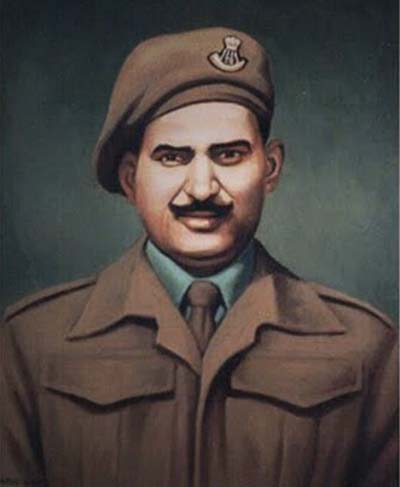 CHM Piru Singh s/o Lal Singh was born in village Beri, Jhunjhunu in Rajasthan. On May 20, 1936, he was enrolled in Rajputana Rifles. His battalion 6 Rajputana Rifles was moved from Uri sector to Tithwal sector during Kashmir operations in July 1948. Indian troops were deployed across Kishanganga, when Raiders launched a strong counter offensive on forward posts. 163 brigade had to withdraw on home side of Kishanganga River and took up defences on Tithwal Ridge.
CHM Piru Singh s/o Lal Singh was born in village Beri, Jhunjhunu in Rajasthan. On May 20, 1936, he was enrolled in Rajputana Rifles. His battalion 6 Rajputana Rifles was moved from Uri sector to Tithwal sector during Kashmir operations in July 1948. Indian troops were deployed across Kishanganga, when Raiders launched a strong counter offensive on forward posts. 163 brigade had to withdraw on home side of Kishanganga River and took up defences on Tithwal Ridge.
D coy of 6 Rajputana Rifles was tasked to attack a hill feature south of Tithwal, which was strongly held by enemy with MMG and Mortar support. As the attack progressed, Piru Singh’s section, which was the leading section of the coy came under heavy fire. Half of the section was mowed down but he encouraged the remaining section to press on the attack. He himself was hit several times, headed for the MMG bunker crawling silently and entered from rear and killed the MMG crew with his Dagger, thus silencing the Medium Machine Gun which was creating havoc. He was fired upon again from another bunker. He was alone and profusely bleeding. He jumped in to enemy trench and killed another two soldiers firing LMG. While heading for third bunker, he was hit on the head and dropped dead but he had lobbed a grenade, which exploded killing another two soldiers. The act of gallantry was witnessed by his Coy Commander. For this act of single handed bravery and determined cold courage, under heavy enemy fire, CHM Piru Singh in best traditions of Army was awarded Param Vir Chakra posthumously.
Lance Naik Karam Singh, 1 Sikh
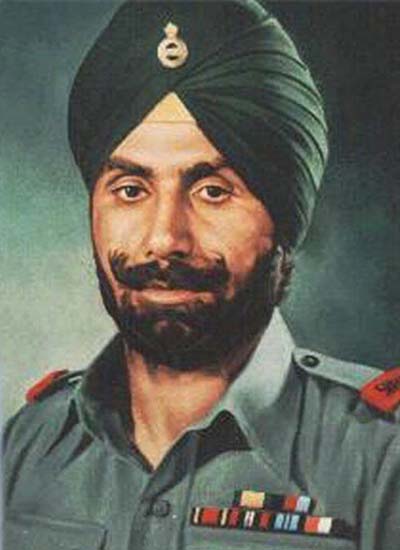 He was born in village Mallan, Sangrur District, Punjab on September 15, 1915. His father Sardar Uttam Singh was the village Sarpanch. He was enrolled in 1 SIKH in 1941. He was with the battalion, which saw action in Middle East. He was awarded a military medal for gallantry. His battalion during Kashmir War performed in superb manner and saved Tithwal from Raiders several times. Tithwal was recaptured from Pak Army assisted Raiders on May 23, 1948 after prolonged battle. After that they made several attempts to reoccupy Richmar Gali and Tithwal, but were repulsed.
He was born in village Mallan, Sangrur District, Punjab on September 15, 1915. His father Sardar Uttam Singh was the village Sarpanch. He was enrolled in 1 SIKH in 1941. He was with the battalion, which saw action in Middle East. He was awarded a military medal for gallantry. His battalion during Kashmir War performed in superb manner and saved Tithwal from Raiders several times. Tithwal was recaptured from Pak Army assisted Raiders on May 23, 1948 after prolonged battle. After that they made several attempts to reoccupy Richmar Gali and Tithwal, but were repulsed.
On October 13, 1948, enemy made a plan to capture Richmar Gali in a brigade level operation, then bypass Tithwal and head for Srinagar valley. L/ Nk Karam Singh’s section was deployed on Richmar Gali and was guarding the approach. His location was heavily bombarded by Mortars and Guns. The bunkers in the section were damaged. The communication trenches also caved in. Karam Singh kept his troops alert and motivated. He repulsed the first attack killing thirty of the Raiders. Second attack was also blunted. There were 50 % casualties in his section. Wounded were attended in lull period. He himself suffered several gunshot wounds. There were six more attacks but he held on. Enemy dead were found all over. The enemy finally withdrew early morning. His location was reinforced. He was known as Wall of Tithwal. For his steel determination, raw courage, conspicuous bravery in face of enemy, was awarded the highest gallantry award.
The units which excelled during Kashmir War of 1947-48, are as listed below with gallantry awards Param Vir Chakra (PVC), Mahavir Chakra (MVC), Vir Chakra (VrC).

We must salute our legendry Indian commanders especially Gen K M Cariappa, Gen Sri Nagesh, the resolute Gen K S Thimayya, Air Commodore Mehar Singh, who made Leh landing, Lt Col Rajinder Singh Sparrow, Lt Col Dewan Rai and brave troops of Indian Army who fought valiantly with the invaders in spite of inclement weather, treacherous terrain, dizzy heights and especially those unsung heroes who made supreme sacrifices for integration of Jammu Kashmir and Ladakh in India.
-The writer is an Indian Army veteran and a defence analyst. He has keen interest in Geo-strategic affairs and writes regularly on internal and external affairs issues related to India and neighbours. The views expressed are personal and do not necessarily reflect the views of Raksha Anirveda.
-The writer is an Indian Army veteran and a defence analyst. He has keen interest in Geo-strategic affairs and writes regularly on internal and external affairs issues related to India and neighbours. The views expressed are personal and do not necessarily reflect the views of Raksha Anirveda

